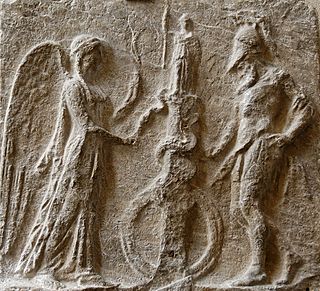 W
WThe Iliad is an ancient Greek epic poem in dactylic hexameter, traditionally attributed to Homer. Set during the Trojan War, the ten-year siege of the city of Troy (Ilium) by a coalition of Greek states, it tells of the battles and events during the weeks of a quarrel between King Agamemnon and the warrior Achilles.
 W
WHelmets using ivory from boar's tusks were known in the Mycenaean world from the 17th century BC to the 10th century BC. The helmet was made through the use of slivers of boar tusks which were attached to a leather base, padded with felt, in rows. A description of a boar's tusk helmet appears in book ten of Homer's Iliad, as Odysseus is armed for a night raid to be conducted against the Trojans.Meriones gave Odysseus a bow, a quiver and a sword, and put a cleverly made leather helmet on his head. On the inside there was a strong lining on interwoven straps, onto which a felt cap had been sewn in. The outside was cleverly adorned all around with rows of white tusks from a shiny-toothed boar, the tusks running in alternate directions in each row. Μηριόνης δ' Ὀδυσῆϊ δίδου βιὸν ἠδὲ φαρέτρην καὶ ξίφος, ἀμφὶ δέ οἱ κυνέην κεφαλῆφιν ἔθηκε ῥινοῦ ποιητήν: πολέσιν δ' ἔντοσθεν ἱμᾶσιν ἐντέτατο στερεῶς: ἔκτοσθε δὲ λευκοὶ ὀδόντες ἀργιόδοντος ὑὸς θαμέες ἔχον ἔνθα καὶ ἔνθα εὖ καὶ ἐπισταμένως: μέσσῃ δ' ἐνὶ πῖλος ἀρήρει.
 W
WThe Catalogue of Ships is an epic catalogue in Book 2 of Homer's Iliad (2.494–759), which lists the contingents of the Achaean army that sailed to Troy. The catalogue gives the names of the leaders of each contingent, lists the settlements in the kingdom represented by the contingent, sometimes with a descriptive epithet that fills out a half-verse or articulates the flow of names and parentage and place, and gives the number of ships required to transport the men to Troy, offering further differentiations of weightiness. A similar, though shorter, Catalogue of the Trojans and their allies follows (2.816–877). A similar catalogue appears in the Pseudo-Apollodoran Bibliotheca.
 W
WThe section of the Iliad that ancient editors called the Dios apate stands apart from the remainder of Book XIV. In this episode, Hera makes an excuse to leave her divine husband Zeus; in her deception speech she declares that she wishes to go to Oceanus, "origin of the gods", and Tethys the "mother". Instead Hera beautifies herself in preparation for seducing Zeus and obtains the help of Aphrodite. In the climax of the episode Zeus and Hera make love hidden within a golden cloud on the summit of Mount Ida. By distracting Zeus, Hera makes it possible for the Greeks to regain the upper hand in the Trojan War.
 W
WThe extent of the historical basis of the Homeric epics has been a topic of scholarly debate for centuries. While researchers of the 18th century had largely rejected the story of the Trojan War as fable, the discoveries made by Heinrich Schliemann at Hisarlik reopened the question in modern terms, and the subsequent excavation of Troy VIIa and the discovery of the toponym "Wilusa" in Hittite correspondence has made it plausible that the Trojan War cycle was at least remotely based on a historical conflict of the 12th century BC, even if the poems of Homer are removed from the event by more than four centuries of oral tradition.
 W
WIn Search of the Trojan War is a 6-part BBC TV documentary series written and presented by Michael Wood, first broadcast in 1985 on BBC2. It examines the extent to which historical and archeological evidence matches the tale of the Trojan War as recounted by Homer in The Iliad.
 W
WJoachim Latacz is a German classical philologist.
 W
WIn Greek mythology Nestor's Cup is a legendary golden mixing cup which was owned by the hero Nestor. The cup is described in the Iliad.
 W
WNestor's cup is an eighth century BC wine cup discovered in 1954 in Lacco Ameno on Ischia, the ancient Pithekoussai, an island in the Gulf of Naples (Italy). The cup has a three-line inscription, one of the earliest surviving examples of writing in the Greek alphabet.
 W
WIn Greek and Roman mythology, the palladium or palladion was a cult image of great antiquity on which the safety of Troy and later Rome was said to depend, the wooden statue (xoanon) of Pallas Athena that Odysseus and Diomedes stole from the citadel of Troy and which was later taken to the future site of Rome by Aeneas. The Roman story is related in Virgil's Aeneid and other works. Rome possessed an object regarded as the actual Palladium for several centuries; it was in the care of the Vestal Virgins for nearly all this time.
 W
WThe shield of Achilles is the shield that Achilles uses in his fight with Hector, famously described in a passage in Book 18, lines 478–608 of Homer's Iliad. The intricately detailed imagery on the shield has inspired many different interpretations of its significance, with no definitive answer.
 W
WA Tabula Iliaca is a generic label for a calculation of the days of the Iliad, probably by Zenodotus, of which twenty-two fragmentary examples are now known. The Tabulae Iliacae are pinakes of early Imperial date, which all seem to have come from two Roman workshops, one of which seems to have been designed to satisfy a clientele of more modest aspirations.
 W
WThe Trojan Battle Order or Trojan Catalogue is an epic catalogue in the second book of the Iliad listing the allied contingents that fought for Troy in the Trojan War. The catalogue is noted for its deficit of detail compared to the immediately preceding Catalogue of Ships, which lists the Greek contingents, and for the fact that only a few of the many Trojans mentioned in the Iliad appear there.